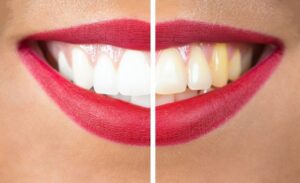Pride in your teeth’s appearance will encourage you to smile more, introducing a vast array of enhancements in your mood and your overall health. But you might want to hide your smile if your teeth form discoloration or stains. And you will therefore miss out on these wellness advantages.
Your dentist can help you brighten your tooth color, but the cosmetic dental treatment they provide will depend on the type of stains you develop on your smile. Read on to learn about the two forms of dental discoloration as well as how your dentist can help you treat them to achieve the whiter smile of your dreams.

Extrinsic Dental Stains
Extrinsic dental stains, also known as surface stains, refer to a type of discoloration that occurs on the outer layer of the tooth, which is called enamel. These stains form on the outermost part of the tooth.
Your toothbrush and floss along with the abrasive ingredients in toothpaste can scrub away surface stains in many cases. But your oral hygiene regimen cannot remove all instances of extrinsic dental stains. Complete consistent and thorough oral hygiene, including visiting your dentist for routine teeth cleanings, to avoid forming deeper versions of these stains.
Extrinsic stains usually form from consuming substances that contain staining agents, such as dark-colored foods and beverages. These items get their dark color from tannins, a substance that will transfer to the teeth and absorb into the enamel as you consume them.
You can see stubborn stains form over time. So pay attention to your diet to learn if it impacts the appearance of your smile. Avoid tobacco products which can also cause this effect on your tooth color.
Your dentist can help you eradicate these stains that do not go away with your usual oral hygiene regimen. They can offer in-office teeth whitening treatment. This process involves a dentist applying a bleaching gel to the teeth that will lift stains which can then easily wash away.
The dentist may also offer take-home whitening kits which feature custom-made trays filled with bleaching gel. They gradually brighten your tooth color to remove these stains when worn as directed. Discover if this targeted treatment can enhance your smile when you visit your cosmetic dentist.
Intrinsic Dental Stains
Your smile might also develop intrinsic dental stains over time. This tooth discoloration forms far deeper in the enamel which your oral hygiene tools cannot reach. Similarly, bleaching agents in your dentist’s teeth whitening treatment cannot penetrate to these stains to get rid of them either.
Fortunately, your dentist can use other cosmetic dental solutions to address these more stubborn dental stains. They can cover this discoloration using cap-like fixtures that attach to the front of teeth called porcelain veneers. Your dentist builds these on a custom basis for each patient so that you can see a gorgeous and natural-looking finish.
Intrinsic stains often form due to factors outside of your control. For instance, you might see yellowing or stains develop as a side effect of certain medicines.
Aging may lead to weakening in the enamel which will lead to discoloration too. Contact your dentist to find ways to preserve and improve your tooth color.
